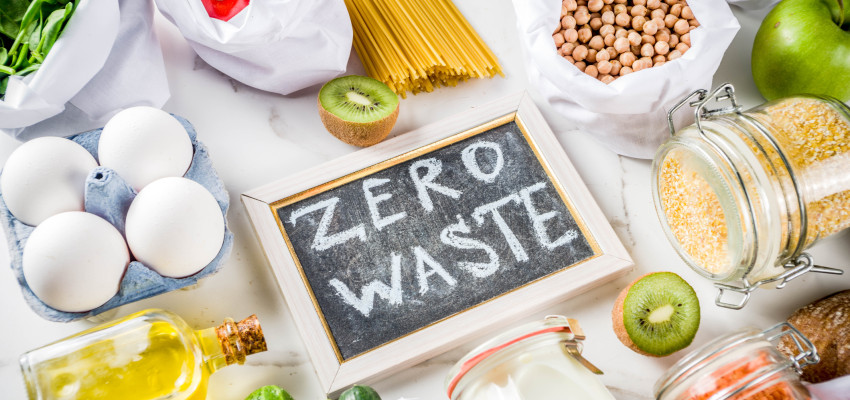By Dixie Vogel on December 11, 2019
Food Waste Solutions

“Starving children in China would love to have those peas.”
Like many mothers of the era, my mom tried to encourage me to clean my plate by invoking starving Chinese children. It never worked very well.
“You can send them mine!” I'd brightly reply.
Admittedly sketchy on the logistics, I was earnest in the desire to share. It took a few years for me to understand the bigger message behind the exhortation.
My folks grew up poor. They knew what it was like to be hungry and they made sure I appreciated having enough food.
Knowing not everyone can take something as fundamental as food for granted makes the idea of wasting it feel particularly egregious. But wasting food isn’t something most people do intentionally.
In fact, most of us probably believe we're wasting less food than we are. In a survey, 76 percent of people believed they waste less food than the average American—a conclusion that's statistically impossible. Clearly, we're not doing as well as we may think.
In the United States, food waste is estimated to claim between 30 and 40 percent of the total food supply. Waste is defined as otherwise edible food that gets discarded.
Those statistics hit even harder when you realize where food becomes waste—at home. According to the United States Department of Agriculture (USDA), of the estimated 133 billion of pounds of edible food wasted in 2010, about a third didn't get discarded until it was at the point of sale or had been taken home.
Impact of Wasted Food
Food waste makes a significant impact on our environment. Food that is harvested but not eaten uses about 25 percent of all water used in agriculture. The same wasted food uses about two percent of the nation's electricity, or enough to power approximately 54 million households for a year.
Wasted food represents approximately eight percent of global greenhouse gas emissions and is the biggest single component of municipal landfills, responsible for significant methane emissions.
On a personal level, food waste is estimated to cost $1,800 annually for a family of four.
Fortunately, a few key adjustments can make a big difference in combating food waste.
Safely Wasting Less Food
"When in doubt, throw it out," the old saying goes.
While that's a reasonable safety guideline, a little bit of information can make the difference between wasted food and dinner.
Use-By Dates Aren't What They Seem
Dates on labels can be confusing. The USDA helps by mapping out what the dates actually mean.
"Best if Used by or Before" or "Use by" dates are referring to the flavor or quality of the food. The same is true for a "Freeze-By" date--it's about taste, not safety. The exception to this rule is baby formula, which carries additional regulations about dates. Always use baby formula by the labeled use-by date.
"Sell-by" dates are to help stores manage inventory rotation. Once again, these dates don't reflect safety concerns. The store expects a delay between someone purchasing food and eating it.
Canned foods often sport a "Best if Used by" date, also referring to when the food is expected to taste the best. You can safely use canned food past the labeled date. Just be sure to discard any cans that are dented, rusted or swollen, as that indicates the seal has been compromised.
Know Your Food: Identifying Spoiled Foods vs. Safe Food
Spoiled foods will have an off odor, or changes in texture or flavor. The changes are the work of the bacteria that spoils food. The bacteria in food require moisture, time and favorable temperatures. So proper food handling can make the difference between safe food and wasted food.
The longer perishable food remains between 40-120 degrees Fahrenheit, the higher the risk it will spoil. Don't leave perishable food unrefrigerated for more than two hours.
Regardless of what the labels say, food that hasn't been handled properly or shows signs of spoiling should be discarded. Your senses will tell you far more about whether food is safe than any date on the package.
Tips for Wasting Less Food
The Environmental Protection Agency (EPA) has plenty of tips to help reduce food waste.
Shopping
Shop your kitchen first. Plan meals around ingredients you need to use up. Use a shopping list and remember, bulk-buy deals aren't really a deal if you can't eat all the food you're buying.
Meal planning
Estimate how many meals you'll eat at home in a week and decide what to serve. Just buy the food you need to make these meals.
Storage
Understand food storage to keep your food fresher, longer. The website SaveTheFood.Com has extensive information on storage and reviving food that’s beginning to fade to get the most value from your grocery budget.
Befriend Ugly Fruits and Vegetables
Purely cosmetic imperfections can keep perfectly good produce from being sold. The more of us willing to buy and use "ugly" foods, the less likely it ends up wasted.
Leftover-Friendly Eating
Collect recipes that are good for using up leftovers. Be on the lookout for creative ways to use food that would otherwise go to waste, like making stock from vegetable scraps, using leftovers in casseroles or frittatas.
Food Rescue Bin
Specify a readily visible bin or section of your refrigerator for food that needs to be used. You're less likely to forget about items when you're seeing them every time you open the fridge.
Issues like food waste can feel too large and overwhelming for individual efforts to matter much. But when you understand how much food is wasted at the consumer level, it's clear nothing else can replace individual efforts.
Everyone in the food supply chain have roles to play. But even the most well-thought-out and expertly executed plans from those involved in the food industry can only go so far if we don't do our part individually.
We may not plan to waste food. But the facts are unavoidable: if we don't plan, we'll end up wasting food. Fortunately, there are plenty of ways to help both the world and ourselves by wasting a little less food.
Learn More
Visit SaveTheFood.Com to get more help with planning tips, recipes and food storage guidelines.


